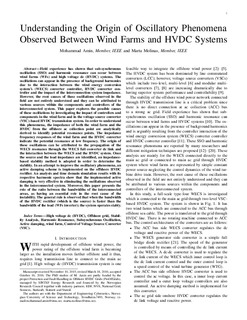| dc.contributor.author | Amin, Mohammad | |
| dc.contributor.author | Molinas Cabrera, Maria Marta | |
| dc.date.accessioned | 2017-05-16T11:18:33Z | |
| dc.date.available | 2017-05-16T11:18:33Z | |
| dc.date.created | 2016-10-24T11:58:20Z | |
| dc.date.issued | 2016 | |
| dc.identifier.citation | IEEE Journal of Emerging and Selected Topics in Power Electronics ( Volume: 5, Issue: 1, March 2017 ) | nb_NO |
| dc.identifier.issn | 2168-6777 | |
| dc.identifier.uri | http://hdl.handle.net/11250/2442636 | |
| dc.description.abstract | Field experience has shown that sub-synchronous oscillation (SSO) and harmonic resonance can occur between wind farms (WFs) and high voltage dc (HVDC) systems. The oscillations can appear in the presence of background harmonics due to the interaction between the wind energy conversion system’s (WECS) converter controller, HVDC converter controller and the impact of the interconnection system impedance. However, the root causes of these oscillations observed in the field are not entirely understood and they can be attributed to various sources within the components and controllers of the interconnected system. This paper explores the possible causes of these oscillations by investigating the impact of controllers and components in the wind farm and in the voltage source converter (VSC)-based HVDC transmission system. In order to understand this phenomena, the impedance of both the wind farm and the HVDC from the offshore ac collection point are analytically derived to identify potential resonance points. The impedance frequency responses of the wind farm and the HVDC converter indicate the potential resonance at low frequency. The origin of these oscillations can be attributed to the propagation of the WECS resonance through the WECS full converter dc link and the interaction between the WECS and the HVDC system. Once the source and the load impedance are identified, an impedancebased stability method is adopted in order to determine the stability. In an attempt to improve the oscillatory phenomena, an active damping scheme is implemented on the offshore HVDC rectifier. An analysis and time domain simulation results with its respective harmonic spectra show that the implemented active damping is very effective in eliminating the oscillations observed in the interconnected system. Moreover, this paper presents the role of the ratio between the bandwidths of the interconnected areas, as having an essential role in the root cause of the instability. The general rule is observed that when the bandwidth of the HVDC rectifier (which is the source) is faster than the bandwidth of the load (WFs inverter); the system operates stably. | nb_NO |
| dc.language.iso | eng | nb_NO |
| dc.publisher | IEEE | nb_NO |
| dc.relation.uri | http://ieeexplore.ieee.org/document/7605516/ | |
| dc.title | Understanding the Origin of Oscillatory Phenomena Observed between Wind Farms and HVDC Systems | nb_NO |
| dc.type | Journal article | nb_NO |
| dc.type | Peer reviewed | nb_NO |
| dc.source.pagenumber | 378 - 392 | nb_NO |
| dc.source.volume | 5 | nb_NO |
| dc.source.journal | IEEE Journal of Emerging and Selected Topics in Power Electronics | nb_NO |
| dc.source.issue | 1 | nb_NO |
| dc.identifier.doi | 10.1109/JESTPE.2016.2620378 | |
| dc.identifier.cristin | 1393983 | |
| dc.description.localcode | © 2017 IEEE. Personal use of this material is permitted. Permission from IEEE must be obtained for all other uses, in any current or future media, including reprinting/republishing this material for advertising or promotional purposes, creating new collective works, for resale or redistribution to servers or lists, or reuse of any copyrighted component of this work in other works | nb_NO |
| cristin.unitcode | 194,63,25,0 | |
| cristin.unitname | Institutt for teknisk kybernetikk | |
| cristin.ispublished | true | |
| cristin.fulltext | original | |
| cristin.qualitycode | 1 | |
